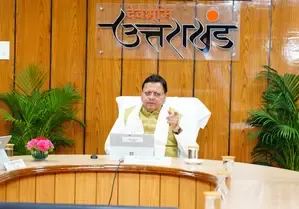Uttarakhand Government Initiates Magisterial Investigation into Mana Avalanche

Synopsis
Key Takeaways
- Uttarakhand government orders magisterial probe.
- Eight workers died in the Mana avalanche.
- 46 individuals were rescued from the incident.
- Inquiry led by Jyotirmath SDM.
- Public testimonies encouraged during investigation.
New Delhi, March 4 (NationPress) The Uttarakhand government has initiated a comprehensive magisterial investigation into the catastrophic avalanche that hit Mana on February 28, which resulted in the death of eight border road construction workers and the rescue of 46 others.
Chamoli district magistrate, Sandeep Tiwari, has assigned Jyotirmath sub-divisional magistrate (SDM) Chandra Shekhar Vashishth to oversee the inquiry, with a provisional deadline of 15 days for the report's submission. However, Tiwari noted that this timeframe might extend to a month.
Tiwari stressed that the investigation will examine every aspect of the tragic occurrence, including possible preventive measures that could have reduced the fatalities. He also encouraged public testimonies, inviting individuals to come forward and provide their accounts during the inquiry.
The perilous avalanche struck the Border Roads Organisation (BRO) camp located between Mana and Mana Pass early on Friday morning, trapping workers who were resting in containers and a shed. These workers were involved in a vital road project linking Mana, the last Indian village, to Mana Pass on the China border.
After the disaster, 36 of the 46 rescued individuals were reported in stable condition and ready for discharge. Eight others received treatment at the army hospital in Jyotirmath, while two were admitted to the All India Institute of Medical Sciences (AIIMS) in Rishikesh.
The rescue operation, which concluded on Sunday, involved over 200 personnel from various agencies, including the Army, ITBP (Indian Tibetan Border Police), BRO (Border Roads Organisation), NDRF (National Disaster Response Force), SDRF (State Disaster Relief Force), and state authorities.
The search and rescue efforts encountered significant challenges due to severe weather conditions, including rugged terrain, heavy snowfall, near-zero visibility, and frigid temperatures at an altitude of approximately 3,200 meters.
By Friday night, 33 workers had been rescued despite adverse weather conditions. The operation was briefly halted due to darkness and resumed on Saturday morning as the weather improved, resulting in the rescue of 17 more individuals, although four succumbed to their injuries.
On Sunday, four bodies were recovered, raising the total number of deceased to eight, with victims originating from Uttar Pradesh, Himachal Pradesh, and Uttarakhand. The bodies of seven victims have been sent to their respective hometowns.
Chief Minister Pushkar Singh Dhami, who conducted an aerial survey of the affected area on Saturday, praised the rescue teams for their remarkable efforts in saving 46 workers.
He highlighted the utilization of all available resources, including advanced technology and equipment such as ground-penetrating radar, to accelerate the rescue mission. Dhami also emphasized the necessity of providing appropriate medical care to all rescued workers.
Recognizing the increased avalanche risk during February and March, Dhami's administration has issued a directive to relocate workers from higher Himalayan regions to safer areas.







